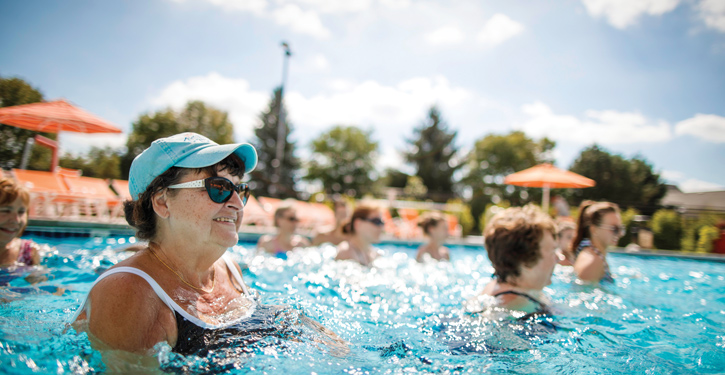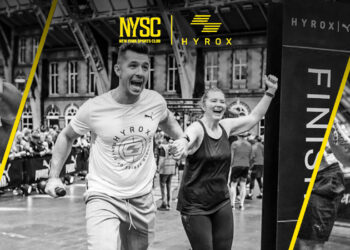Key considerations from industry operators when creating programming for every generation within your walls.
If you aren’t providing a space for every generation, you could be losing out on significant revenue potential. From older adults seeking to live more actively to young children wanting to build healthy habits, fitness centers are recognizing the way to reach the entire community is by programming for every age group.
At the Wisconsin Athletic Club (WAC), Group X classes are often created with certain demographics in mind, even if not explicitly mentioned. For example, the club offers typical Group X classes on cardio, strength yoga, cycling, etc., along with LITE versions meant for older audiences, those new to fitness or people recovering from an injury.
“We try to keep it inclusive, but we definitely see more of an older population attending the LITE classes,” explained Julie Crowley, the director of group fitness at the WAC. “We can add that title to any other class which helps us connect with older populations. Our programs help us bridge the gap between different varieties and levels of fitness within our complimentary offerings.”
Another class included in membership is called Move It for children to exercise while their guardians are working out or in another class. The WAC also has a Kids Clubhouse area where different ages will be highlighted with unique activities and programming.
Having these offerings for multiple generations is a key to success for the WAC which is — as Chez Misko, the COO of the WAC, said — program-centric. As such, the gym can connect with its members at any life stage from baby to senior.
“One of our goals is to get people connected to a person or a program in our club,” said Misko. “When they visit us, they’re not just utilizing a treadmill or working out. They all have different reasons for coming to the club but we want them to be connected. We’ve always taken a generational approach. We really feel the programming is what brings people in and connects them to one another which helps from a retention standpoint.”
Each week, about 600 classes are held across eight WAC locations in cardio, strength, aquatics, boutique fitness and specialty classes. Incorporating sessions on trending topics or focusing on specific areas, like glutes, core, Metabolic Bootcamp, Women and Weights, ballroom dancing, etc., furthers the club’s connection with different generations. For example, younger audiences are causing strength training’s popularity to rise, and older generations are focusing on their core to help them maintain an active life. Having classes for both areas helps serve these groups but also allows generations outside of the targeted demographic to join.
In fact, not marketing specific classes to specific generations has helped the WAC find success in its programming. Instead of labeling classes for seniors, the club created the LITE classes which promotes belonging and increases accessibility. Misko remarked how older adults didn’t want to join a class solely for seniors, but they’ll more readily attend LITE classes with other groups like fitness beginners or those recovering from an injury.
“This goes back to the really important power titles have,” said Misko. “Your programs help them feel they’re doing something they really want to be a part of. We make sure we put people in situations where they’re accomplishing their goals and feel good participating in those programs versus feeling they have to go to a senior program because there are no other classes for them.”
The Reh-Fit Centre employs a similar philosophy making sure all populations are engaged and welcome to programming even with the average age of members being 60. Reh-Fit’s offerings target those managing chronic conditions like arthritis, diabetes and cancer, often through physician referral. Yet, this isn’t your average “seniors-only” club. It opens its doors to all ages and fitness levels, creating a community where everyone feels welcome and engaged.
“We have members in their 70s and 80s taking high-level fitness classes and younger individuals with health concerns finding a home in our lower-function options,” said Rhea Vaags-Olafson, the director of health and fitness at Reh-Fit. “We’re committed to ensuring anyone, regardless of fitness level, can find meaningful engagement.”
The club’s approach goes beyond fitness — it’s about safety, community and purpose. Understanding that older populations face increased fall risks, Reh-Fit offers smaller class sizes and extra staff, creating an environment where members feel supported and safe.
Plus, the Centre’s impact stretches beyond physical health as there’s an important social component as well. The WHO reports one-third of older adults experience loneliness, something Reh-Fit tackles head-on. Its cafe has become a community hub, bringing members together for connection and camaraderie.
“COVID-19 brought to light how much our members need a sense of belonging,” explained Vaags-Olafson. “Our cafe is often buzzing with members socializing before and after classes. They’re here for the community as much as the fitness.”
Reh-Fit’s success also stems from its relationships with healthcare providers, forming a trusted referral network that sustains membership and strengthens the club’s impact. “We’ve been a staple in this city for 45 years,” said Vaags-Olafson. “That history and our relationships with local health care providers have built us into a trusted resource in medical fitness. Some of our members have been with us for over four decades because of it.”
Other communities clubs are tapping in to include families and children.
Andrew Hennebelle, the director of PWR — which stands for performance, wellness and recovery — at UFC GYMS described the club as a family facility. Classes begin with six-year-olds with Kids Club programming. Other youth programming UFC GYM has done include anti-bullying seminars, summer camps and summer Olympics.
When someone turns 13, they can enter the training floor and train with their guardian or participate in a class with other adults.
“These opportunities allow them to start that important focus of fitness as a lifestyle,” explained Hennebelle. “This serves as an extension to physical education in a school setting and parents are able to participate with their children and teach them proper habits.”
Outside of youth activities, Hennebelle emphasized how every generation is open to join in other programming. One area the gym has found success in is recovery because of its benefits that transcend generational divides. Offering cryotherapy from CryoBuilt, Hyperice’s compression therapy equipment among other amenities has helped them serve multiple groups.
“We’re incorporating elements of cryotherapy, self-regeneration, restoration, muscle soreness and reducing inflammation to give the body back its restorative properties,” said Hennebelle. “Recovery is one of those pieces that all of us are going to experience at some point.”
Finding ways to appeal to multiple generations can be a game-changer and lead to boosted revenue and retention. By offering diverse classes and activities, a club can show its values of bringing fitness to everyone. As generations grow and the industry evolves, finding ways to ensure members feel welcome and connected tells them you’ll always be there to support their wellness journey.










